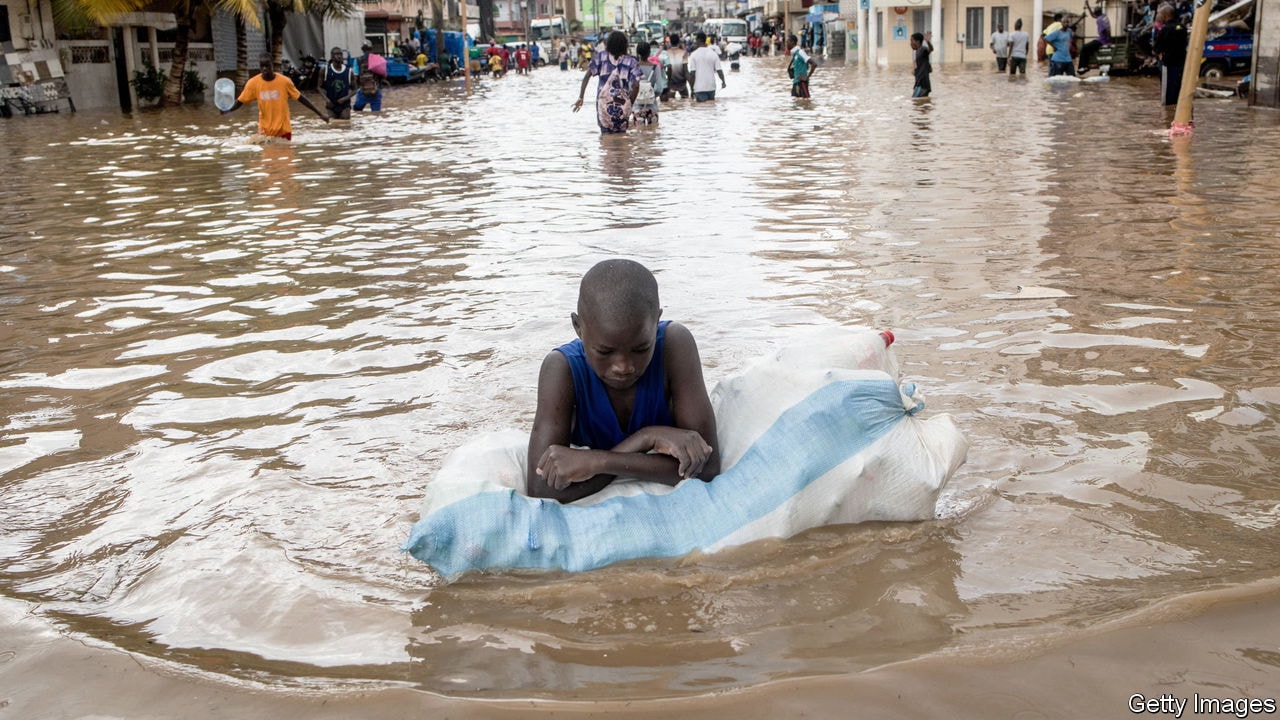
“It was a wave of water,” says Oulimata Sambe. She factors out the still-sodden armchairs, muddy wardrobe and the water stain a metre and a half up the wall in her small home in Ngor, a fishing village inside Dakar, the capital of Senegal. “I had two grandkids on my bed, I had to evacuate them out of the window,” she provides. Not distant, underpasses on Dakar’s scenic corniche grew to become car-swallowing lakes. Just weeks earlier one other downpour had turned quiet streets in Dakar into raging rivers and collapsed a bit of motorway.
Similar occasions frequently happen throughout the area. Recent flooding and landslides additionally killed eight individuals in Freetown, the capital of Sierra Leone. In June flooding killed 12 individuals in Abidjan, the business capital of Ivory Coast. Floods in Lagos, Nigeria’s business capital, claimed one other seven lives. Even when they don’t seem to be lethal, metropolis floods break lives and livelihoods. Storm water not too long ago inundated the largest textile market in Kano, a metropolis in northern Nigeria, destroying a whole lot of 1000’s of {dollars}’ value of materials.
Unusually heavy rains have turn out to be considerably extra widespread over the previous 30 years, leaving large numbers of individuals in danger (see map). In locations that is partly due to deforestation. A current examine by Christopher Taylor of the uk Centre for Ecology and Hydrology, a analysis institute, and his co-authors discovered that afternoon rainstorms in deforested components of coastal west Africa occur twice as usually in contrast with 30 years in the past. Their frequency went up by solely a couple of third in locations that stored their forests.
Some of essentially the most denuded—and thus drenched—locations are coastal cities akin to Freetown and Monrovia, the capital of Liberia. Yet areas deep inland are additionally in danger. Some 340,000 individuals have been hit by current flooding in Chad. Worryingly, the Intergovernmental Panel on Climate Change (ipcc) predicts there can be heavier downfalls extra usually throughout most of Africa because the planet warms up.
Yet common flooding of cities in west Africa is just not solely attributable to heavier rain. Breakneck, unplanned urbanisation can be in charge. As cities have grown, builders have thrown up concrete partitions haphazardly with little considered offering drainage, making it more durable for water to discover a clear path to the ocean. As ever bigger areas have been paved over, there was much less uncovered soil into which water can gently sink away. And as cities get extra full of new arrivals, their few functioning drains get overwhelmed or clogged.
Unplanned urbanisation also can put extra individuals in hurt’s method. Fully 40% of the individuals who settled within the outskirts of Dakar between 1988 and 2008 made their properties in areas which might be at important threat of flooding or coastal erosion.
Untrammelled growth is damaging city forests and wetlands, too. Ordinarily they need to assist take in water and scale back floods. In Freetown, some residents constructed on a hillside in a protected forest reserve, destabilising the soil. In 2017 it collapsed after three days of rain, killing greater than 1,100 individuals. In Ghana, builders have encroached on maybe 40% of the internationally recognised wetlands, together with some defending Accra, the capital.
Flooding imposes financial prices, in addition to human ones. Even regular rain in Dakar creates a swampy gridlock throughout town and badly slows enterprise—other than the few courageous hawkers who wade between stationary vehicles promoting their wares. The World Bank discovered that in 2017 flooding in coastal areas brought about harm value nearly 3% of gdp in Ivory Coast and 1.4% in Senegal. One examine discovered that households hit by pure disasters in Senegal have been 25% extra prone to fall into poverty.
“All our belongings are ruined,” says Yaya, a mom of six whose one-room dwelling in Dakar was not too long ago swamped. She needed to throw away the sodden mattress she shared along with her youngsters, which pushed her into debt. A brand new mattress price 75,000 cfa francs ($115), however she may solely scrape collectively a 3rd of that. “I will pay little by little,” she explains. With curiosity, she may even pay extra. Nearby Fatou surveys her small store’s once-prized fridge with dismay. “I bought it for 250,000 cfa,” she says. “Now it’s bust.”
After brutal floods in 2012 President Macky Sall of Senegal introduced a $1.4bn ten-year flood-prevention plan. The authorities has constructed 43 pumping stations in Dakar and its surrounds and added new drainage canals, too. Accra launched the same programme in 2019. In some components of Dakar these efforts have helped. Yet in a lot of west Africa progress is sluggish. Informal settlements are sometimes essentially the most in danger, however governments don’t at all times recognise them, which suggests they’re much less doubtless to assist make them safer, says Jessica Troni of the un Environment Programme.
Even in Senegal, some are asking questions on the place precisely the flood-prevention cash went. In 2016 a deputy minister within the accountable ministry admitted to the nationwide meeting that she didn’t know the way the funds have been used. She was fired quickly after.
In Ngor, many are dismissive of the response. “The government doesn’t do anything,” grumbles Abdoulaye, as he unloads tuna from his pirogue. “It’s anarchy.” Some assume that the authorities have made the realm extra susceptible to flooding, as a result of they directed storm water from different neighbourhoods upstream right into a canal that passes by means of Ngor. Meanwhile, as they do yearly, residents of Dakar mop up and wrestle to hold on with their lives. Ms Sambe says somebody from the native mayor’s workplace came visiting and promised help. Yet that was weeks in the past. “They’ve done nothing,” she says.